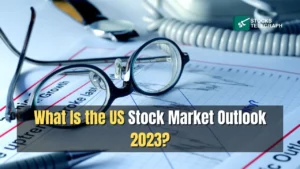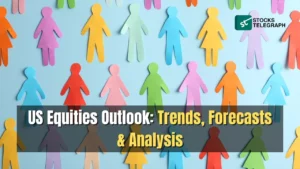Currently, all eyes are steadfastly fixed on the US bank stocks outlook as the year 2025 approaches, brimming with anticipation for its performance.
For both institutional investors and eager newcomers, the fate of the banking sector serves as a compass, guiding decisions that ripple through portfolios and economies alike.
With the profound global shifts seen in recent years, as well as technological leaps amid the US tech stocks outlook, and regulatory currents constantly reshaping the US stock outlook today, the critical importance of the banking sector’s trajectory remains unshakable.
Wall Street analysts are particularly focused on the performance of the US banking sector, attempting to decode the intricate dance of market forces.
As fiscal narratives merge with innovation and policy, the forthcoming year’s US bank stocks outlook becomes more than mere figures – it emerges as a pivotal narrative relating to the overall economic projection, impacting every industry.
Duration Mismatch and Asset Quality
When it comes to peering into the US bank stocks outlook, an apparent duration mismatch looms as a challenge.
This disconnect arises from the stark contrast between the long-term, low-yield fixed-income securities and loans in banks’ asset portfolios and the comparatively shorter-term liabilities they hold.
Analysts and Wall Street expects have cautioned how this may be a serious red flag towards another banking crisis.
With the growing surge in interest rates, a pressing concern emerges the decline in the value of bank assets, a result of this duration mismatch.
This dissonance underscores the fragility of the industry, as some assets, deceptively categorized as “held-to-maturity,” remain unmarked to market, painting a distorted picture of fiscal robustness, which could be disastrous for the US equity market outlook.
As investors assess the US bank stocks outlook, they must scrutinize this discord between assets and liabilities, recognizing its potential implications for the stability and financial health of banking stocks.
Challenges Facing the US Banking Industry
The US banking sector, despite short-term stabilization measures, grapples with significant challenges as it looks toward 2025. These hurdles relating to US bank stocks outlook encompass:
-
Balance Sheet Quality Concerns
The impact of rising interest rates has raised questions about the quality of banks’ balance sheets. This has led to a disparity between asset and liability durations, leaving institutions exposed to potential economic shifts.
-
Asset Valuation Pressure
Increasing interest rates have negatively affected the value of fixed-income securities and loans. This phenomenon has put a strain on asset valuation and added complexities to banks’ financial positions. This is also impactful for the US equities outlook.
-
Liquidity Struggles
Banks are contending with persistent liquidity challenges. In response, many are reshaping their balance sheets to enhance liquidity profiles, sometimes at the cost of capital levels, which has definitely been a trend in the US stock market outlook 2023.
-
Solvency and Profitability
Broader questions of solvency and profitability loom. The competition for liquidity at elevated rates impacts profitability, while concerns about capital levels persist.
In the midst of these challenges, banks must adeptly navigate the intricacies of asset-liability management, credit quality, and financial stability in order to thrive in the coming years.
Growing Bankruptcy Filings
In our US bank stocks outlook for 2025, one of the most notable concerns is that bankruptcy filings surged notably during the initial half of the US markets outlook 2023, marking a stark contrast to the preceding year. This trend bears a critical implication for the future trajectory of banking stocks.
The upswing trend in bankruptcy filings could exert pressure on banking institutions, potentially affecting their asset quality and financial stability.
The issue of interest rate fluctuations and persisting economic challenges further compounds the situation. Elevated interest rates might accentuate the burden on borrowers, potentially translating into amplified default rates, particularly among small businesses.
This scenario could potentially strain the loan portfolios of banks and reverberate into the profitability metrics of financial institutions.
As investors navigate the road ahead toward the US investment outlook for 2025, the surge in bankruptcy filings, influenced by interest rate shifts and economic uncertainties, emerges as a significant factor to monitor.
The implications on US stocks, and particularly US banking stocks, will hinge on how institutions manage credit risks and adapt to evolving economic conditions in the coming years.
Conclusion
As the countdown to 2025 gains momentum, the spotlight intensifies on US bank stocks, serving as barometers of financial landscape shifts. The banking sector’s trajectory retains paramount importance amid global flux and technological leaps.
Wall Street analysts meticulously decode the sector’s intricate dance, revealing a narrative intertwined with economic projections and industry impacts.
Yet, amid anticipation, there are several challenges that cloud the horizon for investors. The dichotomy between long-term assets and short-term liabilities warns of a potential crisis.
Rising interest rates accentuate these concerns, straining asset valuation and liquidity. The solvency-profitability interplay adds complexity, prompting rigorous asset-liability management.
Similarly, bankruptcy filings’ surge in 2023 amplifies these concerns. As investors march towards 2025, prudence is essential, acknowledging the bankruptcy surge as a bellwether of banking stock fortunes in the current climate for the US bank stocks outlook.
Frequently Asked Questions
What Are Banking Stocks?
Banking stocks represent shares of companies in the financial sector that provide banking and financial services.
Why Should I Invest in Banking Stocks?
Investing in banking stocks can offer the potential for capital appreciation and dividends, as banks play a crucial role in the economy.
What Factors Can Influence Banking Stock Prices?
Factors like interest rates, economic conditions, regulatory changes, and bank-specific financial performance can impact banking stock prices.
Are Banking Stocks Considered Volatile?
Yes, banking stocks can be volatile due to their sensitivity to economic shifts, interest rate changes, and market sentiment. This is fundamental to consider in the US investment outlook 2023.
How Do Interest Rates Affect Banking Stocks?
Higher interest rates can boost banks’ profitability by increasing their net interest margin, potentially leading to positive effects on banking stock prices.
What Is the Role of Regulations in Banking Stocks?
Regulations can impact banking operations, risk management, and profitability, influencing the performance of banking stocks.
What Are the Risks Associated with Investing in Banking Stocks?
Risks include credit losses, economic downturns, regulatory compliance challenges, and market volatility that can affect the value of banking stocks.
Do Banking Stocks Pay Dividends?
Yes, many banking stocks provide dividends as a way to distribute a portion of their profits to shareholders.
How Can I Analyze Banking Stocks Before Investing?
Analyze financial statements, growth prospects, risk management, and the overall economic environment to assess the potential of banking stocks.
Can Global Economic Trends Impact Banking Stocks?
Absolutely, global economic trends can influence banking stocks as they operate within interconnected financial systems, making them sensitive to global economic shifts.













